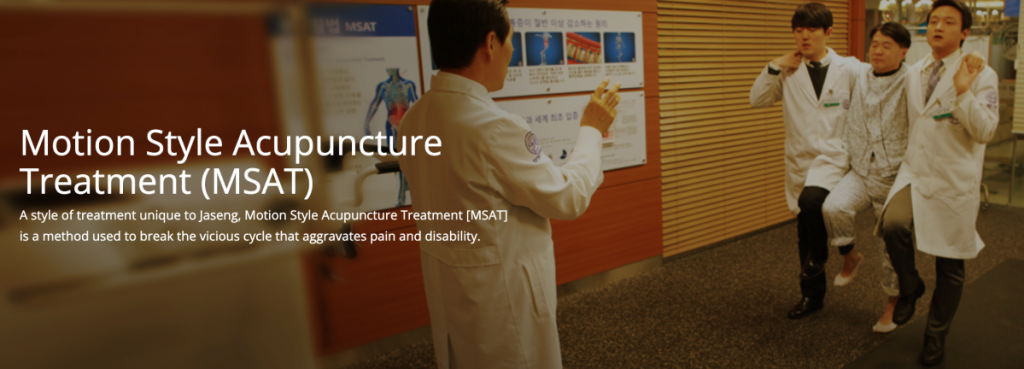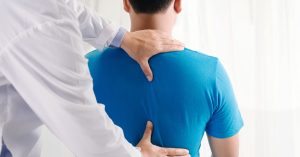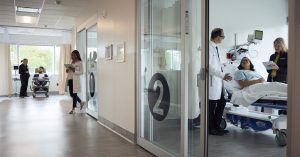MSAT for MSK pain – The BMAS Blog

Stimulated by a trip to Jaseng, Seoul, for their 4th annual academic conference, and a paper from the founder of Jaseng, published in Pain 10 years ago, Shin et al 2013.[1]
MSAT – motion style acupuncture treatment
MSK – musculoskeletal
cLBP – chronic low back pain
US – ultrasound
TP – transverse process
CAT – conventional acupuncture treatment
RCT – randomised controlled trial
ODI – Oswestry Disability Indexkey to acronyms
This is the first blog I have written at 36 000 feet. I am not sure if I will make a habit of this, but it is a long flight (13h 30m) and I am in clinic tomorrow morning. My day today has a lot of extra time as I am flying west with the sun, so it will be expanded up to 32 hours.
I should make the most of it, but as usual the cabin crew want to get the big fancy meal out of the way as soon as possible. That’s great if you want alcohol fuelled sleep, but not so good if you want to write a coherent blog and not miss the hospitality.
Talking of hospitality, I cannot remember when I was treated so well. That’s probably my poor memory, but the welcome in Seoul was very warm and the transport was rather posh. There was a lot of respectful bowing as well… I quite liked it and found myself joining in.
Jaseng was first set up in 1990 by Dr Joon-Shik Shin after inheriting his father’s clinic 2 years before. Now it is a very large organisation with multiple hospitals in Korea and even one in California, as well as a large herbal medicine dispensary. The organisation specialises in the non-surgical treatment of spinal disorders and other MSK conditions.
It has some unique interventions including MSAT and a particular molecule derived from Korean herbal medicine called Shinbaromectin. There are also some special herbal formulae handed down within the Shin family.
I witnessed a treatment at the main Jaseng hospital in Gangnam the day before the conference along with other speakers and guests. The patient was suffering from cLBP and left radicular symptoms. She had had a previous laminectomy and fusion at L5/S1 for lateral canal stenosis, but her pain had returned after some time.
The treatment started with chuna – a Korean form of manual therapy. This was applied relatively gently to the dorsal spine with the patient lying prone on special couch. Next acupuncture needling was applied to taut bands in erector spinae in the lumbar region above the site of previous surgery. The needles were stimulated, and the tissues nearby were gently tapped whilst the practitioner spoke to the patient, describing what was happening and reassuring her. The needles were retained for only a few minutes. Then came the US machine to find the tip of the left TP at L5. The US probe was moved fractionally below and lateral to the TP and then a 70 to 90mm fine gauge hypodermic needle was inserted in plane with the probe just past the position of the TP. Roughly 10mls of an injectable herbal solution was gradually introduced. The target was the region of the left L5 nerve root some distance lateral to the foramina. This injection looked as if it was a little painful and the practitioner continued reassuring the patient as her left leg trembled.
The patient then turned over, so she was lying supine, and the practitioner then applied manual therapy to the diaphragm under the costal margins on both sides simultaneously whilst she performed deep breathing. He then moved on to apply manual pressure over the right followed by the left psoas through the abdomen. This looked painful and was probably curtailed.
Finally, we came to the first demonstration of MSAT. The patient stood up and walked to a device that was hanging from a set of tracks on the ceiling. A couple of assistants secured the patient to the device with a large corset-like fastening while the practitioner inserted needles in 5 acupuncture points – one midline at the top of the neck (GV16) and two bilateral points in the limbs (LI11 and LR2). The device was adjusted to take 26kg of the patient’s weight and she started to walk in a slow stepping, high knee gait along a long, narrow foam mat. She placed each foot carefully as if exaggerating the normal human gait and foot contact with what was a somewhat unstable surface of the 60mm foam mat. After several marches up and back along the 10m mat the treatment was over and the needles removed. The patient returned to her ward. She was having daily treatment as an inpatient.
Before the ceiling mounted device was developed, this technique was performed with an assistant on each side of the patient, taking some of the patient’s weight and providing support. The assistants would march with high knees in time with the patient.
Over the course of the weekend, we saw several live demonstrations along with some videos illustrating the use of MSAT for other parts of the body, namely the neck, shoulder, and jaw.
The first RCT studying this technique addressed the effect of MSAT in acute LBP with ODI scores of 60% or more (n=58).[1] Patients were assessed for suitability and serious diseases were excluded, such as cancer, vertebral fracture, and spinal infection. LBP plus or minus leg pain was present for less than 4 weeks. The patients were randomised to either MSAT treatment or intramuscular diclofenac 75mg.
In the MSAT group the ODI dropped by over 30% after 30 minutes and there was little change in the group receiving intramuscular diclofenac. Patients were followed up at 2, 4, and 24 weeks. The MSAT group was better up to the 4-week point, but both groups were essential the same at 24 weeks with minimal disability.
This is an unusual trial, with a dramatic short-term result. It was criticised for its use of the ODI at 30 minutes after the interventions,[2] amongst other things, but the authors responded well to these criticisms.[3]
Subsequently, there have been a handful of papers with MSAT in the title or abstract – some small RCTs and observational studies.[4–9] The largest RCT to date is on shoulder pain (n=164). It is from 2018 was performed in China and used the acronym MSAT in the abstract.[4] The last author has a good research reputation and reviews regularly for us (Acupuncture in Medicine), but the intervention was a more classic treatment involving strong stimulation of a leg point (ST38) whilst the affected shoulder was mobilised. This was referred to as MSAT and was compared in a 4×4 factorial design with conventional acupuncture treatment (CAT – local points and no mobilisation) and minimal versions of both MSAT and CAT. MSAT proved to be better than its minimal version, but CAT did not.
The MSAT for shoulders that I saw in Seoul involved local needling plus assisted active movement, which is different from the more classical technique tested in the Chinese trial.
My impression is that the choice of needle position for MSAT is careful to avoid any excessive discomfort during movement but close enough to the moving parts that there will be some background stimulus in loose connective tissue.
Overall, I think it is an interesting technique with a lot of potential, but it does need more research, which hopefully is underway.
References
1 Shin J-S, Ha I-H, Lee J, et al. Effects of motion style acupuncture treatment in acute low back pain patients with severe disability: a multicenter, randomized, controlled, comparative effectiveness trial. Pain 2013;154:1030–7. doi:10.1016/j.pain.2013.03.013
2 Magrinelli F, Roncari L, Tamburin S. “Effects of motion style acupuncture treatment in acute low back pain patients with severe disability” by Shin et al. Pain 2014;155:201–2. doi:10.1016/j.pain.2013.08.020
3 Shin J-S, Ha I-H, Lee J, et al. Letter to the editor. Response. Pain 2014;155:202–3. doi:10.1016/j.pain.2013.09.010
4 Shi G-X, Liu B-Z, Wang J, et al. Motion style acupuncture therapy for shoulder pain: a randomized controlled trial. J Pain Res 2018;11:2039–50. doi:10.2147/JPR.S161951
5 Kim D, Park K-S, Lee J-H, et al. Intensive Motion Style Acupuncture Treatment (MSAT) Is Effective for Patients with Acute Whiplash Injury: A Randomized Controlled Trial. J Clin Med 2020;9:2079. doi:10.3390/jcm9072079
6 Noh J-H, Byun D-Y, Han S-H, et al. Effectiveness and safety of motion style acupuncture treatment of the pelvic joint for herniated lumbar disc with radiating pain: A prospective, observational pilot study. Explore 2021;:S1550-8307(21)00189-0. doi:10.1016/j.explore.2021.09.004
7 Lyu R-Y, Wen Z-L, Tang W-C, et al. Data mining-based detection of the clinical effect on motion style acupuncture therapy combined with conventional acupuncture therapy in chronic neck pain. Technol Health Care Published Online First: 28 January 2022. doi:10.3233/THC-228048
8 Park M-J, Jin S-R, Kim E-S, et al. Long-Term Follow-Up of Intensive Integrative Treatment including Motion Style Acupuncture Treatment (MSAT) in Hospitalized Patients with Lumbar Disc Herniation: An Observational Study. Healthcare 2022;10:2462. doi:10.3390/healthcare10122462
9 Hwang DW, Yoo DH, Bae I-S, et al. Effectiveness of motion style acupuncture treatment for patients with shoulder disorders: A prospective observational study. Explore 2023;:S1550-8307(23)00116-7. doi:10.1016/j.explore.2023.04.011




